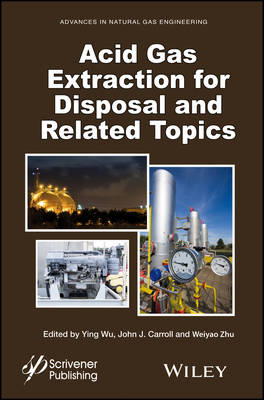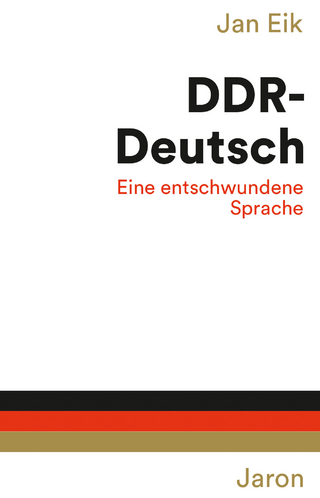
Acid Gas Extraction for Disposal and Related Topics
Wiley-Scrivener (Verlag)
978-1-118-93861-4 (ISBN)
Written by some of the most well-known and respected chemical and process engineers working with natural gas today, the chapters in this important volume represent the most cutting-edge and state-of-the-art processes and operations being used in the field. Not available anywhere else, this volume is a must-have for any chemical engineer, chemist, or process engineer working with natural gas.
There are updates of new technologies in other related areas of natural gas, in addition to the extraction and disposal of acid gas, including testing, reservoir simulations, acid gas injection, and natural gas hydrate formations. Advances in Natural Gas Engineering is an ongoing series of books meant to form the basis for the working library of any engineer working in natural gas today. Every volume is a must-have for any engineer or library.
Ying (Alice) Wu is currently the President of Sphere Technology Connection Ltd. (STC) in Calgary, Canada. From 1983 to 1999 she was an Assistant Professor and Researcher at Southwest Petroleum Institute (now Southwest Petroleum University, SWPU) in Sichuan, China. She received her MSc in Petroleum Engineering from the SWPU and her BSc in Petroleum Engineering from Daqing Petroleum University in Heilongjiang, China. John J. Carroll, PhD, PEng is the Director, Geostorage Process Engineering for Gas Liquids Engineering, Ltd. in Calgary, Canada. Dr. Carroll holds bachelor and doctoral degrees in chemical engineering from the University of Alberta, Edmonton, Canada, and is a registered professional engineer in the provinces of Alberta and New Brunswick in Canada. His fist book, Natural Gas Hydrates: A Guide for Engineers, is now in its second edition, and he is the author or co-author of 50 technical publications and about 40 technical presentations. Weiyao Zhu is Professor at University of Science & Technology Beijing in China and Adjunct Professor in State Key Lab of Enhanced Oil and Gas Recovery at the Northeast Petroleum University. He has published more than 100 technical papers and an author of 6 technical books. His research focus is on fluid mechanics in porous media, the theory and application of the multiphase flow for resource exploitation, new energy development, environmental fluid mechanics, and reservoir simulation.
Preface xv
1 Rate-Base Simulations of Absorption Processes; Fata Morgana or Panacea? 1
P.J.G. Huttenhuis and G.F. Versteeg
1.1 Introduction 1
1.2 Procede Process Simulator (PPS) 2
1.3 Mass Transfer Fundamentals 3
1.4 CO2 Capture Case 8
1.5 Conclusions and Recommendations 15
References 16
2 Modelling in Acid Gas Removal Processes 17
Alan E. Mather
2.1 Introduction 17
2.2 Vapour-Liquid Equilibria 18
2.3 Modelling 21
2.3.1 Empirical Models 22
2.3.2 Activity Coefficient Models 22
2.3.3 Two (and more) Solvent Models 23
2.3.4 Single Solvent Models 24
2.3.5 Equation of State Models 24
2.4 Conclusions 25
References 26
3 Thermodynamic Approach of CO2 Capture, Combination of Experimental Study and Modeling 29
Karine Ballerat-Busserolles, Alexander R. Lowe, Yohann Coulier, and J.-Y. Coxam
3.1 Introduction 30
3.2 Thermodynamic Model 31
3.3 Carbon Dioxide Absorption in Aqueous Solutions of Alkanolamines 32
3.4 Conclusion 35
References 36
4 Employing Simulation Software for Optimized Carbon Capture Process 39
Wafa Said-Ibrahim, Irina Rumyantseva, and Manya Garg
4.1 Introduction 40
4.2 Acid Gas Cleaning – Process and Business Goals 40
4.3 Modeling Gas Treating in Aspen HYSYSR 42
4.3.1 Inbuilt Thermodynamics 43
4.3.2 Rate-Based Distillation in Aspen HYSYS 44
4.4 Conclusion 45
References 46
5 Expectations from Simulation 47
R. Scott Alvis, Nathan A. Hatcher, and Ralph H. Weiland
5.1 Introduction 48
5.2 Realism 48
5.2.1 Conclusion 1 49
5.2.2 Conclusion 2 50
5.2.3 Conclusion 3 50
5.2.4 Conclusion 4 51
5.3 Reliability of Simulation Data: What’s Data and What’s Not 52
5.3.1 Conclusion 5 54
5.3.2 Conclusion 6 54
5.3.3 Conclusion 7 55
5.3.4 Conclusion 8 55
5.4 Case Studies 56
5.4.1 Hellenic Petroleum Refinery Revamp 56
5.4.2 Treating a Refinery Fuel Gas 58
5.4.3 Carbon Dioxide Removal in an LNG Unit 60
5.4.4 Tail Gas Treating 65
5.5 Concluding Remarks 67
References 67
6 Calorimetry in Aqueous Solutions of Demixing Amines for Processes in CO2 Capture 69
Karine Ballerat-Busserolles, Alexander R. Lowe, Yohann Coulier, and J.-Y. Coxam
6.1 Introduction 70
6.2 Chemicals 72
6.3 Liquid-Liquid Phase Equilibrium 73
6.4 Mixing Enthalpies of {Water-Amine} and {Water-Amine-CO2} 75
6.4.1 Excess Enthalpies 77
6.4.2 Enthalpies of Solution 78
6.5 Acknowledgements 79
References 79
7 Speciation in Liquid-Liquid Phase-Separating Solutions of Aqueous Amines for Carbon Capture Applications by Raman Spectroscopy 81
O. Fandiño, M. Yacyshyn, J.S. Cox, and P.R. Tremaine
7.1 Introduction 81
7.2 Experimental 84
7.2.1 Materials 84
7.2.2 Sample Preparation 84
7.2.3 Raman Spectroscopic Measurements 85
7.2.4 Methodology Validation 86
7.2.5 Laser Selection Optimization 86
7.3 Results and Discussion 87
7.3.1 Ammonium Carbamate System 87
7.3.2 Methylpiperidine Band Identification 88
7.3.3 (N-methylpiperidine + Water + CO2) System 89
7.3.4 (2-methylpiperidine + Water + CO2) System 90
7.3.5 (4-methylpiperidine + Water + CO2) System 91
7.4 Conclusions 91
7.5 Acknowledgements 92
References 93
8 A Simple Model for the Calculation of Electrolyte Mixture Viscosities 95
Marco A. Satyro and Harvey W. Yarranton
8.1 Introduction 95
8.2 The Expanded Fluid Viscosity Model 98
8.3 Results and Discussion 99
8.3.1 EF Model for Salts Neglecting Dissociation 100
8.3.2 EF Model for Ionic Species 102
8.4 Conclusions 104
References 104
9 Phase Equilibria Investigations of Acid Gas Hydrates: Experiments and Modelling 107
Zachary T. Ward, Robert A. Marriott, and Carolyn A. Koh
9.1 Introduction 107
9.2 Experimental Methods 108
9.3 Results and Discussion 110
9.4 Conclusions 112
9.5 Acknowledgements 112
References 112
10 Thermophysical Properties, Hydrate and Phase Behaviour Modelling in Acid Gas-Rich Systems 115
Antonin Chapoy, Rod Burgass, Bahman Tohidi, Martha Hajiw, and Christophe Coquelet
10.1 Introduction 116
10.2 Experimental Setups and Procedures 117
10.2.1 Saturation and Dew Pressure Measurements and Procedures 117
10.2.2 Hydrate Dissociation Measurements and Procedures 119
10.2.3 Water Content Measurements and Procedures 120
10.2.4 Viscosity and Density Measurements and Procedures 120
10.2.5 Frost Point Measurements and Procedures 120
10.2.6 Materials 121
10.3 Thermodynamic and Viscosity Modelling 122
10.3.1 Fluid and Hydrate Phase Equilibria Model 122
10.4 Results and Discussions 128
10.5 Conclusions 136
10.6 Acknowledgements 136
References 136
11 “Self-Preservation” of Methane Hydrate in Pure Water and (Water + Diesel Oil + Surfactant) Dispersed Systems 141
Xinyang Zeng, Changyu Sun, Guangjin Chen, Fenghe Zhou, and Qidong Ran
11.1 Introduction 142
11.2 Experiments 142
11.2.1 Material 142
11.2.2 Apparatus 143
11.2.3 Experimental Procedure 146
11.3 Results and Discussion 146
11.3.1 Self-Preservation Effect without Surfactant in Low Water Cut Oil-Water Systems 146
11.3.2 Self-Preservation Effect without Surfactant in High Water Cut Oil-Water Systems 148
11.3.3 The Effect of Different Surfactants on Self-Preservation Effect in Different Water Cut Oil-Water Systems 149
11.4 Conclusions 151
11.5 Acknowledgement 151
References 151
12 The Development of Integrated Multiphase Flash Systems 153
Carl Landra, Yau-Kun Li, and Marco A. Satyro
12.1 Introduction 154
12.2 Algorithmic Challenges 155
12.3 Physical-Chemical Challenges 156
12.4 Why Solids? 156
12.5 Equation of State Modifications 157
12.6 Complex Liquid-Liquid Phase Behaviour 160
12.7 Hydrate Calculations 162
12.7 Conclusions and Future Work 165
References 167
13 Reliable PVT Calculations – Can Cubics Do It? 169
Herbert Loria, Glen Hay, Carl Landra, and Marco A. Satyro
13.1 Introduction 169
13.2 Two Parameter Equations of State 171
13.3 Two Parameter Cubic Equations of State Using Volume Translation 172
13.4 Three Parameter Cubic Equations of State 175
13.5 Four Parameter Cubic Equations of State 177
13.6 Conclusions and Recommendations 177
References 180
14 Vapor-Liquid Equilibria Predictions of Carbon Dioxide + Hydrogen Sulfide Mixtures using the CPA, SRK, PR, SAFT, and PC-SAFT Equations of State 183
M. Naveed Khan, Pramod Warrier, Cor J. Peters, and Carolyn A. Koh
14.1 Introduction 184
14.2 Results and Discussion 185
14.3 Conclusions 188
14.4 Acknowledgements 188
References 188
15 Capacity Control Considerations for Acid Gas Injection Systems 191
James Maddocks
15.1 Introduction 191
15.2 Requirement for Capacity Control 192
15.3 Acid Gas Injection Systems 196
15.4 Compressor Design Considerations 197
15.5 Capacity Control in Reciprocating AGI Compressors 199
15.6 Capacity Control in Reciprocating Compressor/PD Pump Combinations 213
15.7 Capacity Control in Reciprocating Compressor/Centrifugal Pump Combinations 215
15.8 Capacity Control When Using Screw Compressors 215
15.9 Capacity Control When Using Centrifugal Compression 218
15.10 System Stability 219
15.11 Summary 220
Reference 220
16 Review and Testing of Radial Simulations of Plume Expansion and Confirmation of Acid Gas Containment Associated with Acid Gas Injection in an Underpressured Clastic Carbonate Reservoir 221
Alberto A. Gutierrez and James C. Hunter
16.1 Introduction 222
16.2 Site Subsurface Geology 223
16.2.1 General Stratigraphy and Structure 224
16.2.2 Geology Observed in AGI #1 and AGI #2 227
16.3 Well Designs, Drilling and Completions 227
16.3.1 AGI #1 228
16.3.2 AGI #2 231
16.4 Reservoir Testing and Modeling 232
16.4.1 AGI #1 233
16.4.2 Linam AGI #2 233
16.4.3 Comparison of Reservoir between Wells 234
16.4.4 Initial Radial Model and Plume Prediction 234
16.4.5 Confirmation of Plume Migration Model and
Integrity of Caprock 236
16.5 Injection History and AGI #1 Responses 236
16.6 Discussion and Conclusions 238
References 241
17 Three-Dimensional Reservoir Simulation of Acid Gas Injection in Complex Geology – Process and Practice 243
Liaqat Ali and Russell E. Bentley
17.1 Introduction 244
17.2 Step by Step Approach to a Reservoir Simulation Study for Acid Gas Injection 245
17.3 Seismic Data and Interpretation 245
17.4 Geological Studies 246
17.5 Petrophysical Studies 246
17.6 Reservoir Engineering Analysis 247
17.7 Static Modeling 247
17.8 Reservoir Simulation 248
17.9 Case History 249
17.10 Injection Interval Structure and Modeling 249
17.11 Petrophysical Modeling and Development of Static Model 250
17.12 Injection Zone Characterization 251
17.13 Reservoir Simulation 253
17.14 Summary and Conclusions 256
References 257
18 Production Forecasting of Fractured Wells in Shale Gas Reservoirs with Discontinuous Micro-Fractures 259
Qi Qian, Weiyao Zhu, and Jia Deng
18.1 Introduction 260
18.2 Multi-Scale Flow in Shale Gas Reservoir 261
18.2.1 Multi-scale Nonlinear Seepage Flow Model of Shale Gas Reservoir 261
18.2.2 Adsorption – Desorption Model of Shale Gas Reservoir 263
18.3 Physical Model and Solution of Fractured Well of Shale Gas Reservoir 264
18.3.1 The Dual Porosity Spherical Model with Micro-Fractures Surface Layer 264
18.3.2 The Establishment and Solvement of Seepage Mathematical Model 266
18.4 Analysis of Influencing Factors of Sensitive Parameters 273
18.5 Conclusions 277
18.6 Acknowledgements 278
References 278
19 Study on the Multi-Scale Nonlinear Seepage Flow Theory of Shale Gas Reservoir 281
Weiyao Zhu, Jia Deng, and Qi Qian
19.1 Introduction 282
19.2 Multi-Scale Flowstate Analyses of the Shale Gas Reservoirs 283
19.3 Multi-Scale Nonlinear Seepage Flow Model in Shale Gas Reservoir 285
19.3.1 Nonlinear Seepage Flow Model in Nano-Micro Pores 285
19.3.2 Multi-Scale Seepage Model Considering of Diffusion, Slippage 288
19.3.3 Darcy Flow in Micro Fractures and Fractured Fractures 289
19.4 Transient Flow Model of Composite Fracture Network System 291
19.5 Production Forecasting 294
19.6 Conclusions 298
19.7 Acknowledgements 299
References 299
20 CO2 EOR and Sequestration Technologies in PetroChina 301
Yongle Hu, Xuefei Wang, and Mingqiang Hao
20.1 Introduction 302
20.2 Important Progress in Theory and Technology 302
20.2.1 The Miscible Phase Behaviour of Oil-CO2 System 302
20.2.2 CO2 Flooding Reservoir Engineering Technology 304
20.2.3 Separated Layer CO2 Flooding, Wellbore Anti-Corrosion and High Efficiency Lift Technology 306
20.2.4 Long Distance Pipeline Transportation and Injection Technology 306
20.2.5 Produced Fluid Treatment for CO2 Flooding and Cycling Gas Injection Technology 306
20.2.6 CO2 Flooding Reservoir Monitoring, Performance Analysis Technology 307
20.2.7 Potential Evaluation for CO2 Flooding and Storage 308
20.3 Progress of Pilot Area 311
20.3.1 Block Hei59 312
20.3.2 Block Hei79 313
20.4 Conclusions 315
20.5 Acknowledgements 316
References 317
21 Study on the Microscopic Residual Oil of CO2 Flooding for Extra-High Water-Cut Reservois 319
Zengmin Lun, Rui Wang, Chengyuan Lv, Shuxia Zhao, Dongjiang Lang, and Dong Zhang
21.1 Introduction 319
21.2 Overview of CO2 EOR Mechanisms for Extra High Water Cut Reservoirs 320
21.3 Experimental Microscopic Residual Oil Distribution of CO2 Flooding for Extra High Water Cut Reservoirs 321
21.3.1 NMR Theory 321
21.3.2 In situ NMR Test for Water Flooding and CO2 Flooding 322
21.4 Displacement Characteristics of CO2 Flooding and Improve Oil Recovery Method for Post CO2 Flooding 325
21.4.1 CO2 Displacement Characteristics for Extra High Water Cut Reservoirs 325
21.4.2 Improved Oil Recovery for Post CO2 Flooding 326
21.5 Conclusions 327
References 328
22 Monitoring of Carbon Dioxide Geological Utilization and Storage in China: A Review 331
Qi Li, Ranran Song, Xuehao Liu, Guizhen Liu, and Yankun Sun
22.1 Introduction 332
22.2 Status of CCUS in China 332
22.3 Monitoring of CCUS 336
22.3.1 Monitoring Technology at Home and Abroad 336
22.3.2 U-tube Sampling System 341
22.3.3 Monitoring Technologies in China’s CCUS Projects 341
22.4 Monitoring Technology of China’s Typical CCUS Projects 343
22.4.1 Shenhua CCS Demonstration Project 343
22.4.2 Shengli CO2-EOR Project 345
22.5 Environmental Governance and Monitoring Trends in China 345
22.6 Conclusion 351
22.7 Acknowledgements 352
References 352
23 Separation of Methane from Biogas by Absorption-Adsorption Hybrid Method 359
Yong Pan, Zhe Zhang, Xiong-Shi Tong, Hai Li, Xiao-Hui Wang, Bei Liu,Chang-Yu Sun, Lan-Ying Yang, and Guang-Jin Chen
23.1 Introduction 359
23.2 Experiments 361
23.2.1 Experimental Apparatus 361
23.2.2 Materials 362
23.2.3 Synthesis and Activation of ZIF-67 363
23.2.4 Gas-Slurry Equilibrium Experiments 363
23.2.5 Data Processing 364
23.2.6 Breakthrough Experiment 366
23.3 Results and Discussions 367
23.3.1 Adsorbent Characterization 367
23.3.2 Ab-Adsorption Isothermal 368
23.3.3 Breakthrough Experiment 370
23.4 Conclusions 374
23.5 Acknowledgements 374
References 374
Index 377
| Erscheint lt. Verlag | 15.4.2016 |
|---|---|
| Reihe/Serie | Advances in Natural Gas Engineering |
| Sprache | englisch |
| Maße | 158 x 231 mm |
| Gewicht | 680 g |
| Themenwelt | Geisteswissenschaften ► Geschichte |
| Technik ► Bauwesen | |
| Technik ► Elektrotechnik / Energietechnik | |
| ISBN-10 | 1-118-93861-5 / 1118938615 |
| ISBN-13 | 978-1-118-93861-4 / 9781118938614 |
| Zustand | Neuware |
| Haben Sie eine Frage zum Produkt? |
aus dem Bereich


